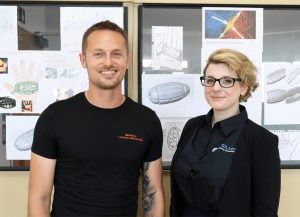Inventor’s boxing training aid punches to success

A new training aid that aims to reduce injury and improve performance for boxers during bag and pad work is being exported across the world, including to the training camp of US boxer Gervonta ‘Tank’ Davis, protégé of Floyd Mayweather.
The Boxing Hand Grenade (BHG) is the brainchild of Shrewsbury-based personal trainer and martial arts instructor John Docherty, who developed the handheld device after sustaining a cumulative injury to his hand and wrist.
Faced with a race to be first to market, he turned to Telford-based Protolabs – the world’s fastest digital manufacturer and a pioneer of advanced manufacturing technologies – to produce a prototype through its PolyJet 3D printing service.
“The idea for the BHG came after I used a piece of foam I found on the gym floor to grip in my fist whilst I was sparring with a client,” said Docherty, whose potential boxing career had to be cut short due to issues with his eyesight.

The device has been designed to fit the contours of the hand and to be worn under traditional boxing hand wraps inside boxing gloves. There are also a number of key features that are enhanced by the 3D printing production process that sets it apart from similar aids.
Flexion grooves allow for the initial surface impact shock dissipation and micro movement of the striking fist, while a future variation of the product will feature a central implosion chamber that allows for the dissipation of the excess impact shock.
Docherty added: “As an entrepreneur with limited resources I needed to find a manufacturing partner that understood what I was trying to create and how important it was to get the product to market before another innovation came to light.
“From the first minute I met engineers from Protolabs, I knew they recognised the urgency, but, equally importantly, identified that a combination of 3D printing for the prototype and injection moulding for production would give me a performance and price point that worked.
“Using the interactive quoting system also enabled me to understand the financial impact of different materials and allowed me to quickly produce a practical and affordable solution for my design.”
Charlotte-Anne Smith, application engineer at Protolabs, said: “We were delighted to help John develop this truly innovative project in such a quick time and at a realistic cost.
“PolyJet 3D printing technology provided outstanding detail, precision and surface smoothness, using a clear digital photopolymer material so that the implosion chamber is visible. This is an exciting innovation for boxing and other martial arts and could prevent hundreds, if not thousands, of long-term injuries.”









